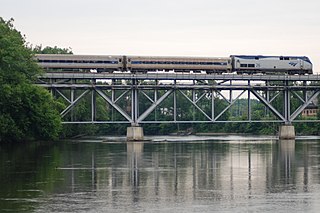
A railroad switch (AE), turnout, or [set of] points (CE) is a mechanical installation enabling railway trains to be guided from one track to another, such as at a railway junction or where a spur or siding branches off.

The Norfolk Southern Railway is a Class I freight railroad operating in the Eastern United States. Headquartered in Atlanta, the company was formed in 1982 with the merger of the Norfolk and Western Railway and Southern Railway. The company operates 19,420 route miles (31,250 km) in 22 eastern states, the District of Columbia, and has rights in Canada over the Albany to Montreal route of the Canadian Pacific Kansas City. Norfolk Southern Railway is the leading subsidiary of the Norfolk Southern Corporation.

The Graniteville train crash was an American rail disaster that occurred on January 6, 2005, in Graniteville, South Carolina. At 2:39 am EST, two Norfolk Southern trains collided near the Avondale Mills plant in Graniteville. Nine people were killed and over 250 people were treated for toxic chlorine exposure. The crash was determined to be caused by a misaligned railroad switch.
On February 8, 1986, in what is now part of Yellowhead County, Alberta, Canada, 23 people were killed in a collision between a Canadian National Railway freight train and a Via Rail passenger train called the Super Continental, including the engine crews of both trains. It was the deadliest rail disaster in Canada since the Dugald accident of 1947, which had 31 fatalities, and was not surpassed until the Lac-Mégantic rail disaster in 2013, which resulted in 47 deaths.

The San Bernardino train disaster, was a combination of two separate but related incidents that occurred in San Bernardino, California, United States: a runaway train derailment on May 12, 1989; and the subsequent failure on May 25, 1989, of the Calnev Pipeline, a petroleum pipeline adjacent to the tracks which was damaged by earth-moving equipment during the crash cleanup.

There have been numerous incidents on the Washington Metro over its history, including several collisions causing injuries and fatalities, and numerous derailments. The Washington Metropolitan Area Transit Authority (WMATA) has been criticized for disregarding safety warnings and advice from experts.

The Michigan Line, sometimes known as the Chicago–Detroit Line, is a higher-speed rail corridor that runs between Porter, Indiana and Dearborn, Michigan. It carries Amtrak's Blue Water and Wolverine services, as well as the occasional freight train operated by Norfolk Southern.
The Worthington Subdivision or Worthington Sub is a railway line operated by Union Pacific Railroad. It runs generally southwest-northeast and begins at a siding in St. James Township, Minnesota, where the Mankato Subdivision ends, and it continues to Sioux City, Iowa. The line has yard facilities in Worthington and Sioux City, as well as a small yard north of Worthington in Hersey and Lorain townships called Elk Creek. The line passes through many small towns and villages with grain elevators along its route, and it is the origin of numerous grain unit trains. As of 2003 the line sees 4 freight trains daily.

On the night of Wednesday, June 21, 1905, the New York Central Railroad's flagship passenger train, the 20th Century Limited, derailed in Mentor, Ohio, on the Lake Shore and Michigan Southern Railway line, killing 21 passengers and injuring more than 25 others on board. A switch from the mainline to a freight siding was open, causing the Limited to leave the mainline and overrun the siding at high speed. The cause of the accident was never officially determined, but overwhelming evidence points to an act of rail sabotage. The 20th Century Limited connected New York City to Chicago; its running time had just weeks earlier been reduced from 20 hours to 18.
At 4:25 pm on July 8, 1986, a 44 car Baltimore and Ohio railroad freight train, traveling at 45 miles per hour, bound south to Cincinnati, derailed near Miamisburg, Ohio, a small city with an industrial history in Montgomery County, southwest of Dayton. Fifteen of the cars derailed on a bridge; these were tank cars containing yellow phosphorus, molten sulfur and tallow. Carrying a chemical used to make rat poison, fireworks and luminescent coatings, one tank car caught fire. This resulted in emission of an estimated 1,000 foot (300 m) high cloud of phosphorus. A subsequent incident caused the largest train accident-triggered evacuation at the time in the United States. The accident was the second major rail disaster in Miamisburg within an eight-year period. On September 10, 1978, 15 cars of a Conrail train derailed.










